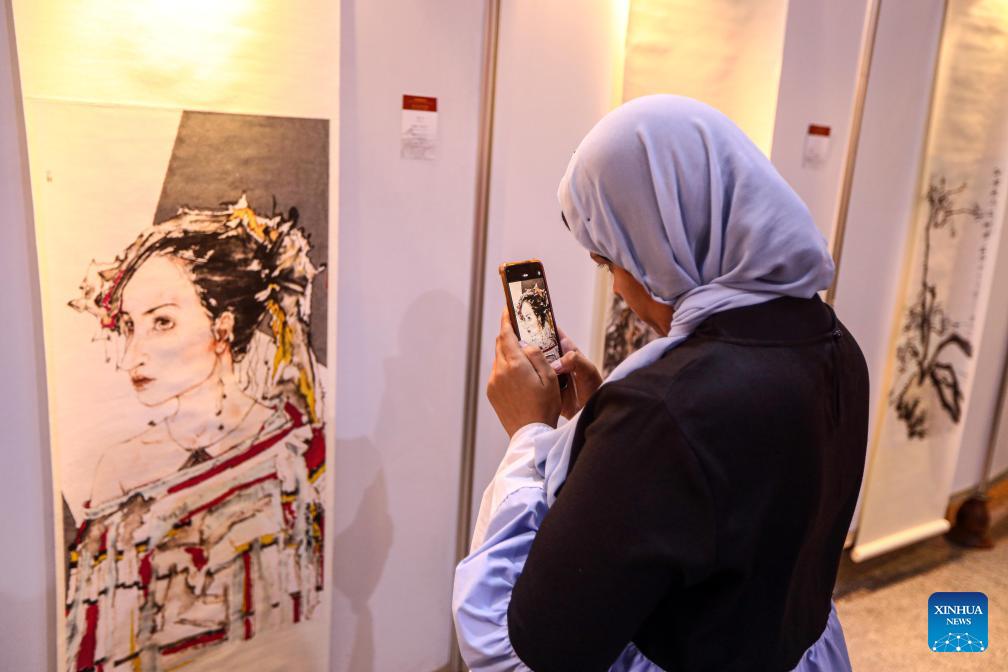Xinhua | May 16, 2024

A visitor films a painting at "the Yellow River Civilization Embracing the Egyptian Civilization" exhibition in Cairo, Egypt, on May 14, 2024. From roaring tigers to delicate purple flowers, a fresh exhibition has captivated visitors in Cairo with works by artists from east China's Shandong Province. Organized by Shandong Painting Academy, "the Yellow River Civilization Embracing the Egyptian Civilization" exhibition was unveiled on Tuesday at the China Cultural Center in Cairo. (Xinhua/Ahmed Gomaa)
From roaring tigers to delicate purple flowers, a fresh exhibition has captivated visitors in the Egyptian capital of Cairo with works by artists from east China's Shandong Province.
Organized by Shandong Painting Academy, "the Yellow River Civilization Embracing the Egyptian Civilization" exhibition was unveiled on Tuesday at the China Cultural Center in Cairo.
Shandong, with the Yellow River flowing through, has played a major role in Chinese history as Chinese civilization began along the lower reaches of the Yellow River. Standing at the crossroads of tradition and progress, Shandong Province has nurtured many contemporary artists.
Egyptian artist Waleed Kanoush, head of the Fine Arts Sector at Egypt's Ministry of Culture, expressed his admiration for the artistic features of Shandong paintings.
"It is a distinguished art exhibition that represents an important overview of the arts and civilization of the great people of China, enhancing the knowledge of the Egyptian public with a very special aspect of creativity," said Kanoush during the event's opening ceremony.
"It also embodies an image of cooperation and friendship between the two peoples, which flourishes day after day at all levels," he said, hailing the Egyptian-Chinese cooperation in the cultural and artistic fields.
Over 20 paintings by renowned Chinese painters were exhibited, including "Tiger Roar in the Bamboos" by Liu Yang, "Purple Flowers" by Li Encheng, "The Rainy Season" by Wu Lei, and "Living in Mountains" by Chang Zhaohui, all of which portrayed unique aspects of Shandong.
Chang emphasized the importance of art as a cultural bridge between countries, expressing his happiness with the favorable response of Egyptian visitors to the Shandong paintings.
"Egyptian-Chinese relations have a long history. We came to the exhibition to display traditional Chinese paintings and introduce Chinese culture and arts to Egyptians," the Chinese painter told Xinhua during the exhibition.
Menna Adel, an 18-year-old who studies Chinese at the Confucius Institute of Ain Shams University in Cairo, said that such cultural activities and galleries help her learn more about Chinese culture and improve her Chinese speaking through communication with native speakers at the same time.
"The paintings are so beautiful. I love Chinese culture and art, so I've chosen to study the language. I am interested in attending such Chinese cultural activities in order to learn more about the Chinese civilization and master the Chinese language," she added.
"I see that the Chinese and the Egyptian peoples have many things in common in terms of customs, traditions, and ancient civilizations," the Egyptian student told Xinhua.
The exhibition's inauguration ceremony attracts Egyptian students, professors, and cultural and educational officials. Officials from Shandong Province and senior diplomats from the Chinese embassy in Cairo also attended the ceremony.
"Today, Shandong, as an important spot for the heritage of the Yellow River civilization, brings artistic creations originated from the banks of the Yellow River to Egypt," Zhang Tao, minister and deputy chief of mission of the Chinese Embassy in Egypt, told the attendees.
"I hope that artists from both countries will create more masterpieces that reflect the friendship between China and Egypt and continue to inject new impetus to enhance the mutual understanding between the two peoples," said the Chinese diplomat.



